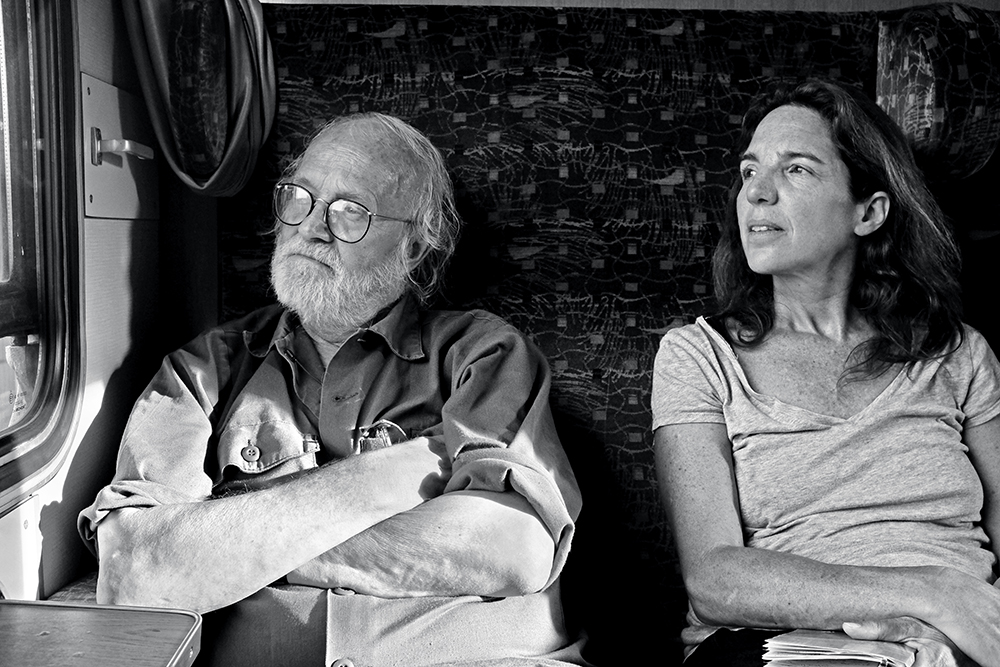
JK and Melissa Harris on the train to Boskovice, 2014. Photograph by Lucina Hartley Koudelka; from Josef Koudelka: Next (Aperture, 2023). © Lucina Hartley Koudelka.
What does it mean to observe the observer?
“It’s a gift, after all these years of editing books and magazines, to take a deep dive with someone I admired and respected, and who I was interested in and curious about,” writer, curator, and National Magazine Award-winning editor Melissa Harris tells Design Observer.
Harris’s latest book is Josef Koudelka: Next, a sweeping visual biography of Czech photographer Josef Koudelka, one of the most celebrated — and private —artists working in the medium. “In a profession with its share of single-minded swaggerers, Koudelka was on another level,” notes Nicholas Dawidoff, reviewing the artist’s most recent show at the Pace Gallery in New York City. “To be his lover, his child, or his friend was to know that his only full commitment was to his camera, and to what he and the camera would do tomorrow.”
Koudelka, now 86, has been at work, documenting the world, for more than sixty years. Among his best-known projects are his coverage of the 1968 Soviet invasion of Prague, the lives of the Romani people, and his focus on the experience of exile, partly his own, becoming stateless when he was forced to leave Czechoslovakia in 1970.
“To be in exile is simply to have left one’s country and to be unable to return. Every exile is a different, personal experience. Myself, I wanted to see the world and photograph it. That’s forty-five years I’ve been travelling. I’ve never stayed anywhere more than three months. When I found no more to photograph, it was time to go,” Koudelka told Le Monde in 2015.
Harris’s commitment to Koudelka rivals that of the artist himself. Her deep dive into his work lasted the better part of a decade, and her interviews and conversations brought her into rich proximity with the artist, his friends, family members, and collaborators around the world. “For me, that was the pleasure. It was the hours I got to spend with him and also everybody in his orbit who mattered to him and who was still living — which was most people.”
The book is co-published by Aperture and the Magnum Foundation. You can flip through it here.
Design Observer’s Jessica Helfand caught up with Harris to learn more about the process of writing the book about a living artist whose figure still looms large. “It was essential that I humanize Koudelka and extricate him from the more reductive and pedestaled realm of myth where so many position him,” she says. “Koudelka has such an isness, is so alive at every moment; I wanted to get at that.”
Jessica Helfand: This is a big book: deeply reported, impeccably contextualized, and artistically and politically illuminating. Can you begin by sharing a little about what you set out to do and how the project evolved over the multiple years that it took you to educate yourself about such a long and complex history?
Melissa Harris: First—thank you so much for the kind words! I really did not have any preconceptions when I began. My self-imposed mandate for the first few years was to cast the net widely and be the most inclusive, precise, and open hunter-gatherer I could be. I wanted to speak with as many key people as possible comprising Koudelka’s world, both past and present; meet with Koudelka intensely once or twice a year for a week to ten days at a time when he’d give me and this project his full attention; read as much as I could about him and his work; and review all possible correspondence, notebooks, etc. At the same time, I needed to understand the twentieth-century history of Czechoslovakia/the Czech Republic, as well as Central and Eastern Europe in general, way better than I did. In all respects I had an expansive learning curve—which I loved!
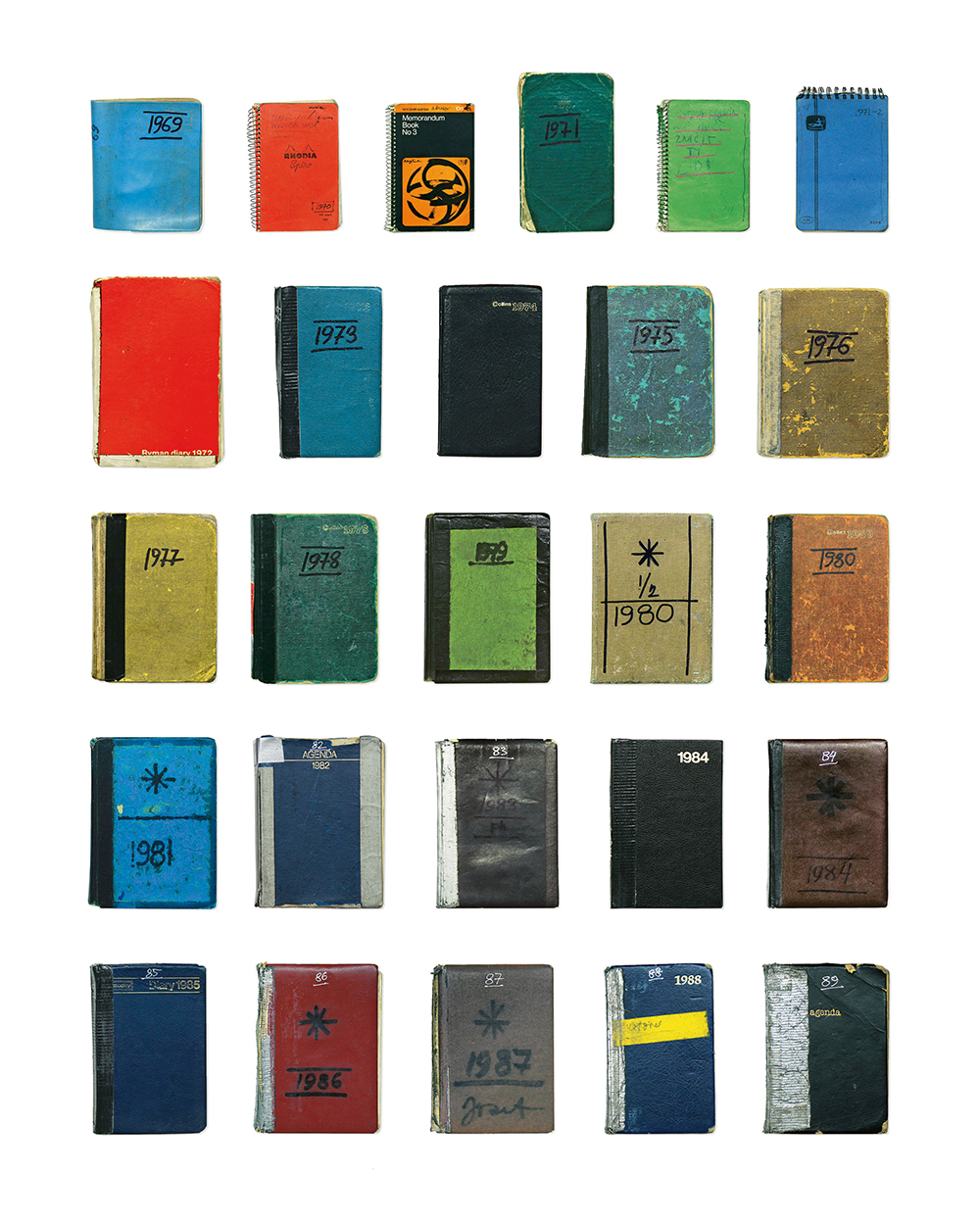
Covers of JK’s diaries, 1969-89; from Josef Koudelka: Next (Aperture, 2023). © 2023 Josef Koudelka/Magnum Photos and courtesy of the Josef Koudelka Foundation.
JH: You observe at one point that Koudelka is “too present to be legendary” (p. 17). Can you say a bit more?
MH: This connects to your first question regarding what I set out to do. It was essential that I humanize Koudelka, and extricate him from the more reductive and pedestaled realm of myth where so many position him. Koudelka has such an isness, is so alive at every moment; I wanted to get at that. He is infinitely more compelling when understood as a unique individual with a complex interior life, demanding of himself and others, who is flawed, who is obsessive and driven, who is hopeful, who is single-mindedly focused, and a relentless perfectionist. This contextualizes his photographic virtuosity rather than making it some sort of divine gift.
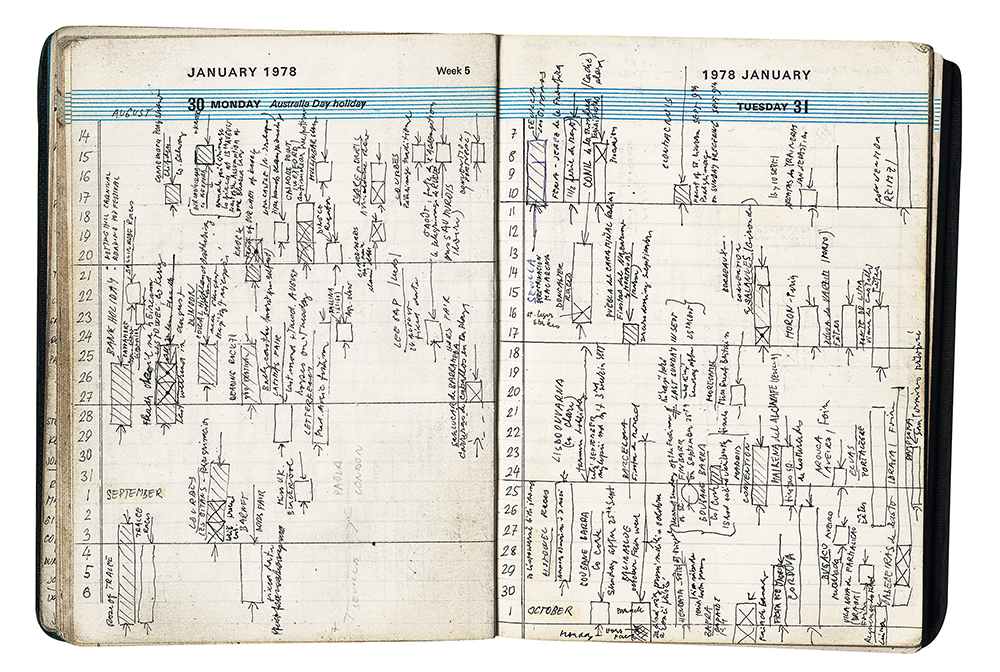
Pages of JK’s 1978 agenda, noting festivals and fairs for August and September; from Josef Koudelka: Next (Aperture, 2023). © 2023 Josef Koudelka/Magnum Photos and courtesy of the Josef Koudelka Foundation.
JH: I was thinking about Henri Cartier-Bresson’s notion of the “decisive moment,” — the idea that a photographer must be able to anticipate an important moment and capture it in real time —but I think you’re describing something else here. Something about focus and drive, about paying attention and, indeed, being present. The line, “It is necessary to repeat in order to go further. To accomplish the maximum,” (p. 21) is one I’d like you to help us unpack.
MH: Yes—exactly. Cartier-Bresson figures prominently in Next, as he and Koudelka were very close, but Koudelka’s way of working is not at all related to the “decisive moment” —beyond his being extraordinarily observant (meaning that, for sure, if something spontaneously occurs that for him has visual merit, he’ll probably take the photo). Instead, Koudelka returns to his subjects again and again, generally over the course of many years, often to exactly the same place to be sure he always achieves the best that he can do—what he refers to as “the maximum.” He watches intently. He waits obsessively. And he tenaciously goes back—to projects, to subjects, to specific images—until he believes he has done all that he can do. In this respect, his patience is seemingly endless.
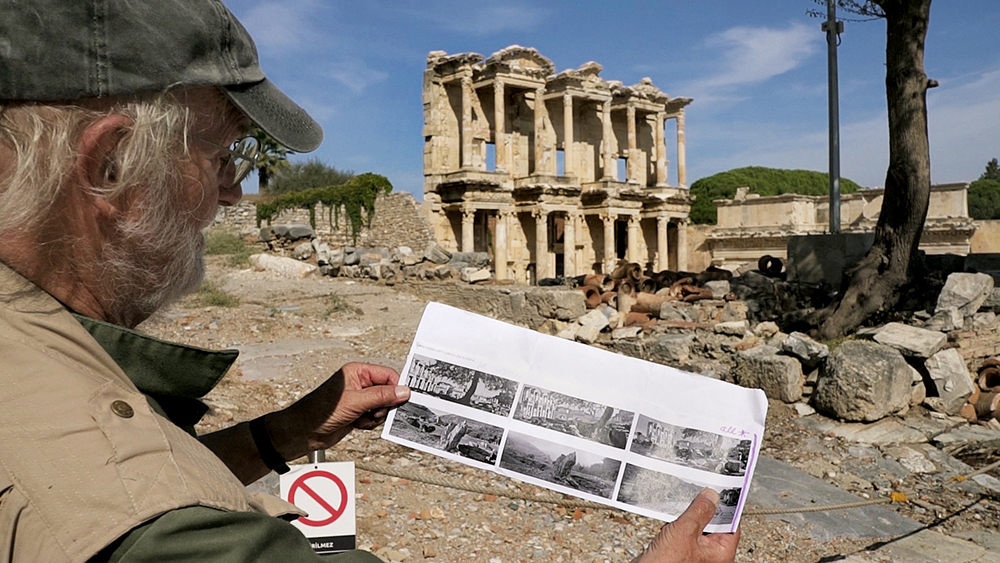
JK considering variations of his photographs of the Library of Celsus, Ephesus, Turkey, in 2015, during the shooting of Coşkun Aşar's Asar's film Crossing the Same River (2021). Photograph by Coşkun Aşar; from Josef Koudelka: Next (Aperture, 2023). © Coşkun Aşar.
JH: Koudelka’s notebooks and diaries are fascinating as objects in themselves, but also compelling as evocations of how his mind works, organizational conceits that reframe time and space and order. I’m therefore curious about this idea of memory as a “creation” (p. 20). How did you come to see these artifacts in the context of Koudelka’s overall approach to his process (and yes, his presence)?
MH: These notebooks, diaries, and even contact sheets are his memory keepers. He does not trust memory—and knows how easy it is for the clarity, the precision, the “truth” to be lost or to shift, whether intentionally or just because of the passing of time. You need to remember—he was born in 1938. So, there were first the Nazis, then the Communists, and then the ’68 Soviet invasion of Prague. Histories were rewritten or recast; truth was more of a relative concept dependent upon who was in control . . . Koudelka is exacting. He wants the precision. He wanted to render his story to me as specifically and honestly as he could. He did not want to rely on his own memories. And so—we often went to his diaries and notebooks and correspondence as the source during our conversations. Also, because he wanted me to understand, and he himself wanted to know, how he felt at the time—not how he felt in the present—about whatever we were discussing that had transpired perhaps thirty years earlier. This is part of what I refer to as his “I-was-there-ness” (p. 10)—how critical it was for him to be bearing witness, with an accuracy and lucidity not sentimentalized or romanticized by the passing of time, to his own life.
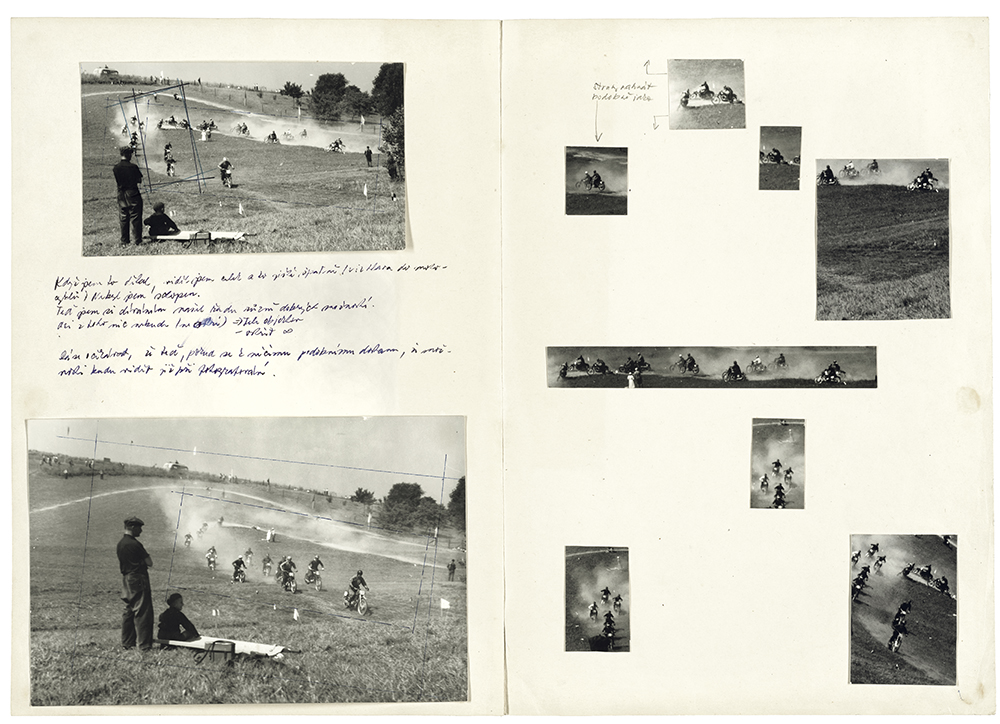
Spread from JK’s notebook of early studies, 1958; from Josef Koudelka: Next (Aperture, 2023). © 2023 Josef Koudelka/Magnum Photos and courtesy of the Josef Koudelka Foundation.
JH: The artistically fertile period following Joseph Stalin’s death seems important in the context of understanding the trajectory of this work. You mention several artists and art directors — Alexey Brodovitch, among others —and write about the radical new freedoms that followed the extended period of restriction and censorship in Eastern Europe. Given the recent rise of censorship in the West, did you find yourself gaining any particular insight about artistic oppression?
MH: Fear, ignorance, and the desire to manipulate and control people politically, intellectually, creatively, socially, morally . . . seem to always be at the base of censorship. That’s also what we saw here in the culture wars of the early 1990s, at that time coming predominantly from the religious right in this country, and what we are experiencing again now from all sides. When freedom of expression is restricted and people or ideas are canceled simply because they offer a perspective different from one’s own, it is the scariest and most chilling of all forms of censorship. It means one only wants one’s own ideas affirmed, that nothing can be challenged, and thus there’s no intellectual rigor or engagement. I cannot imagine a more anti-creative, anti-intellectual, anti-progressive (in the true sense of human progress) way of being in the world. It only polarizes, and people become more and more entrenched and defensive. (To be clear, I’m not including hate speech, which is targeted and intended to be cruel or incite violence, in my definition of freedom of expression.)
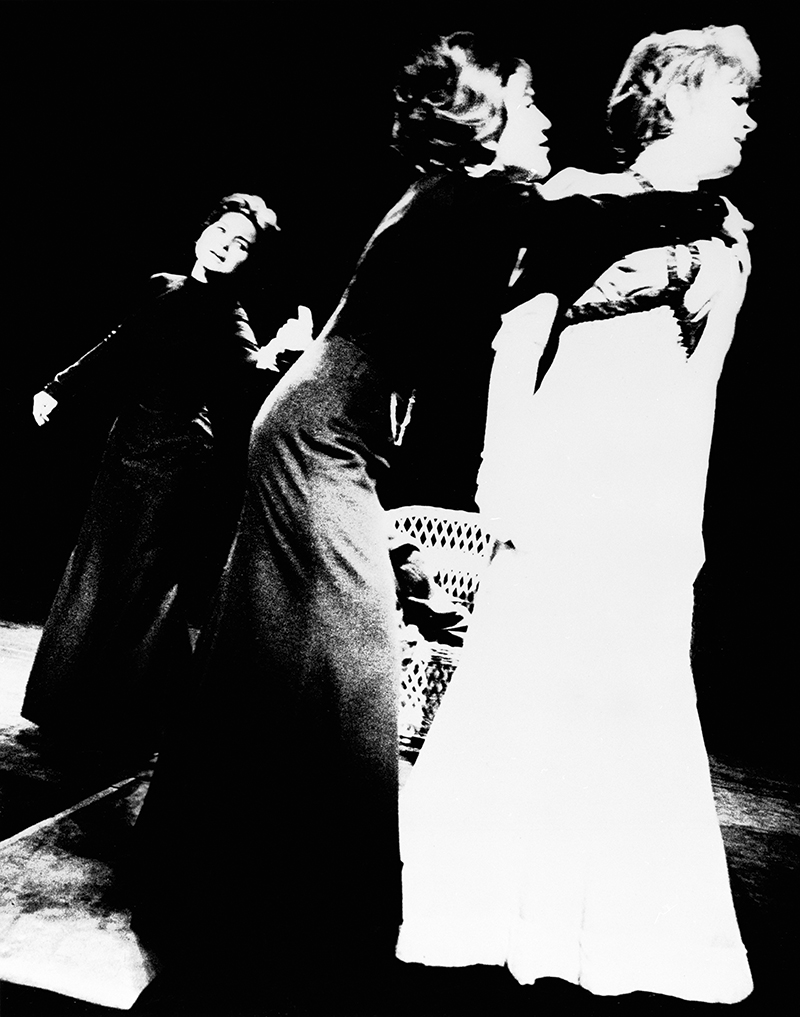
Josef Koudelka. Anton Chekhov's Three Sisters, directed by Otomar Krejča, Divadlo za branou, Prague, 1966; from Josef Koudelka: Next (Aperture, 2023). © 2023 Josef Koudelka/Magnum Photos and courtesy of the Josef Koudelka Foundation.
JH: Let’s turn to theater. Koudelka’s approach to photography and the stage was, as you report it, intuitive: he likely did not read the plays he was photographing. To what degree might this have been a liberating way of visualizing the more human conditions of suspended disbelief—the ugliness in King Lear, for example, or the parody in Ubu Roi?
MH: I think Koudelka wanted to watch and observe and then photograph the interactions in the theater as he did in “real life.” It was a visual decision for him and a way of challenging himself and making entirely original images in the theater. Once, he was working with the director Otomar Krejča and his Divadlo za branou (Theater Beyond the Gate), where Koudelka was permitted to photograph while walking amongst the actors on the stage during rehearsals. He really achieved this less illustrative, more experiential and impressionistic result. As I write in the book, incorporating his words on the theater, “Koudelka was not interested in ‘documenting’ the play—‘a whole in itself.’ He instead considered ‘another possibility: to take the play as an initial reality, and then to make something different out of it—to transform this reality’” (p. 54).
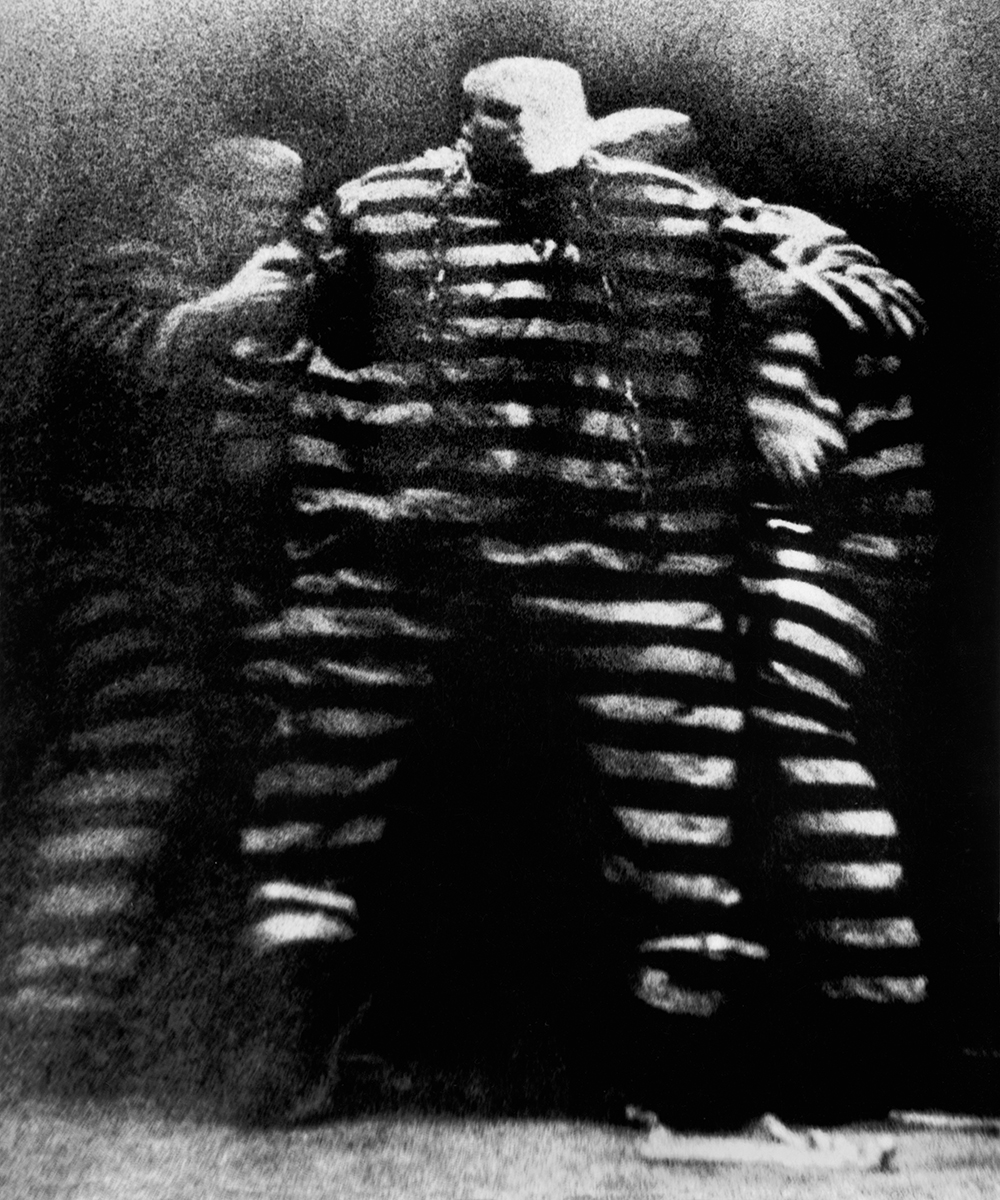
Josef Koudelka. Alfred Jarry's Ubu Roi, directed by Jan Grossman, Divadlo Na zábradli, Prague, 1964; from Josef Koudelka: Next (Aperture, 2023). © 2023 Josef Koudelka/Magnum Photos and courtesy of the Josef Koudelka Foundation.
JH: In addition to highlighting the theatrical work, you also write about Koudelka’s discovery of music at a young age. I’m also curious about the connection between music, theater, and his extensive coverage of the Roma. Did you and/or Koudelka come to see a relationship between these forms of artistic expression?
MH: The music of the Roma is what first attracted him to their world, so music was hugely important in that sense. He soon discovered the visual potential in photographing their communities, often using a wide-angle lens, as he did with his work for Divadlo za branou—although he abstracted his work on the theater by, for example, selecting certain details that he’d rephotograph, in a way he did not do with the Roma. But both his theater work and his project on the Roma are extraordinarily vivid, evoking a spectrum of intense human emotions.
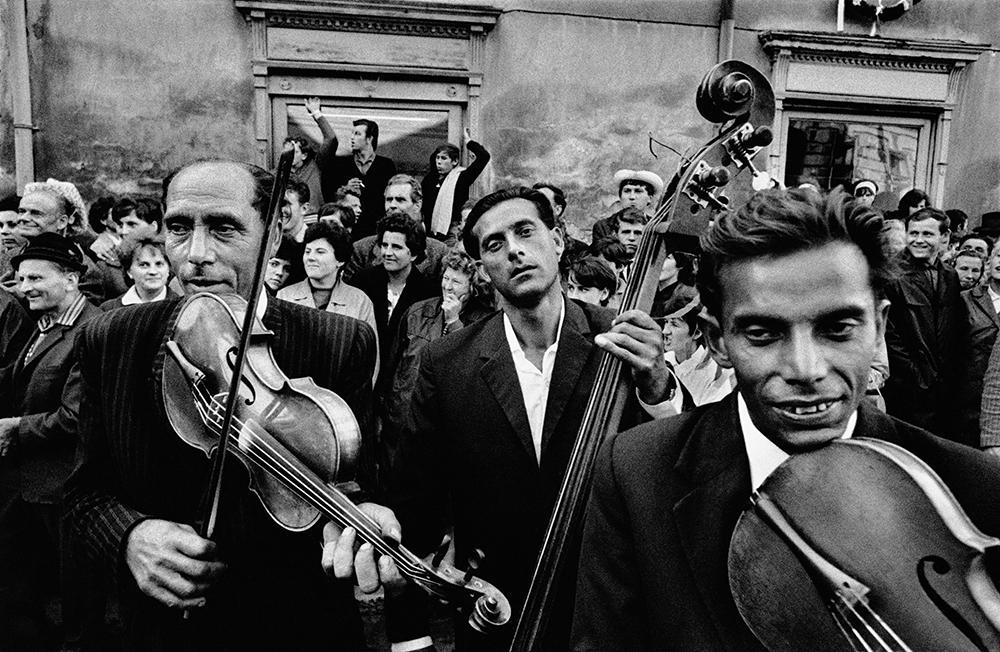
Josef Koudelka. Moravia (Strážnice), 1966; from Josef Koudelka: Next (Aperture, 2023). © 2023 Josef Koudelka/Magnum Photos and courtesy of the Josef Koudelka Foundation.
JH: Given that there’s so much emotion in this work, how to explain the minimalist aesthetic? A deliberate stylistic choice? A kind of salient, pared-down truth-telling? Something else?
MH: I think it’s always important to keep in mind that Koudelka’s first love was airplanes, and his first work was as an engineer. He thinks about form, he thinks about balance, he thinks about geometry, weight . . . All of these considerations are second nature to him (I believe) and are revealed in his images through the formalism you speak of. At the same time, he feels deeply and lives life fervently, and this vitality absolutely energizes the work as well.

Josef Koudelka. France (Nord-Pas-de-Calais), 1989, Josef Koudelka; from Josef Koudelka: Next (Aperture, 2023). © 2023 Josef Koudelka/Magnum Photos and courtesy of the Josef Koudelka Foundation.
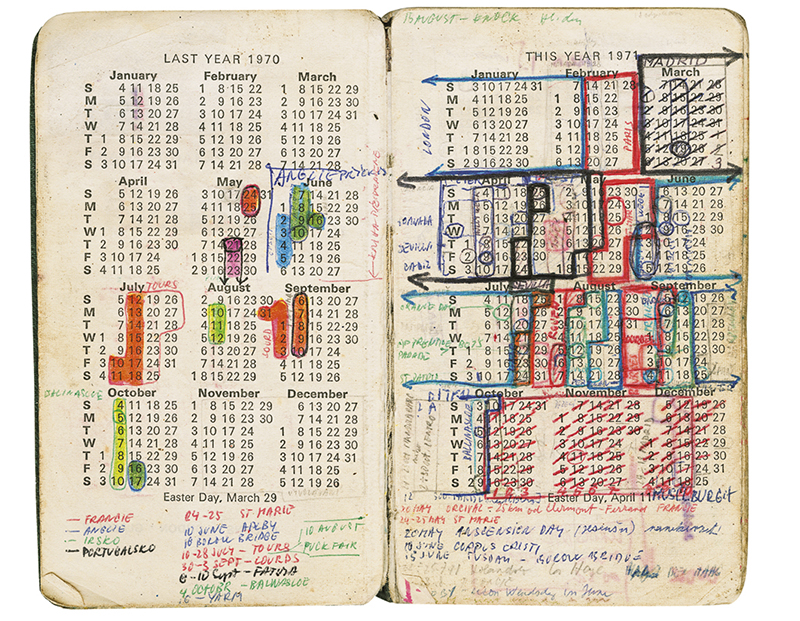
Pages of JK’s 1971 agenda noting travel schedules, color-coded by country; from Josef Koudelka: Next (Aperture, 2023). © 2023 Josef Koudelka/Magnum Photos and courtesy of the Josef Koudelka Foundation.
JH: There’s also a lot of humor in this book—and nods everywhere to humanity writ large. I was surprised that the animal photo of a man crouching in front of a horse (p. 57) is seen as such an icon in Koudelka’s work. Can you say a bit more?
MH: Well, it’s not really an animal photo per se—but here, if you don’t mind, I’ll let a few of the people I interviewed who specifically discuss this image speak to it:
[Divadlo za branou actress Marie] Tomášová has followed Koudelka’s work through the present and is drawn to his “sympathy with the misery of people, with animals, with man, but also with the landscape.” There is one image that, for her, documents how “Koudelka sees not only with his eyes, but with his heart”—one she might well have seen near the time when it was made, in Romania in 1968, shortly before the Soviet-led invasion of Prague. It would first be published in his 1988 book, Exiles:
“I look at the photograph of a horse with its head hanging down. . . . There is a man squatting in front of him with an open mouth. He’s probably saying something. . . . We don’t know what the horse is thinking or feeling. We do know one thing—that Josef is the same way as those two creatures. That’s the empathy and the sincerity with which he does his work.” . . .
During the course of my conversations for this biography, many individuals close to Koudelka focused on it as a signature image that continues to move them, perpetually fixed in their mind’s eye. Among those who spoke of it is Koudelka’s friend, a frequent writer about his work, French philosopher Gilles Tiberghien: “It’s all there,” he says, “all the grays, the whites, the way he composes the scene. . . . It is a world reconciled—the symbiosis of what might be my most beautiful dream, it is the earth—the relationship of man and animal in the world. There are no barriers. This creature who has an unbelievable beauty, and this man who possesses the intimacy of the world.” The French-Lebanese writer Dominique Eddé, who has been close to Koudelka since 1991, observes that this is one of the few images by him in which there is eye contact between two beings. She says:
“I see more tenderness in this image than any other. Even though we are not able to see the horse’s eye. . . . If I was to say what animal Josef would be if he was one, I would say a horse—the stability, the strength, the movement. . . . With this image, we are directly in touch with Josef’s intimacy. This image is, in my view, about the superiority of nature and the humility of love. Both in one. Josef’s vision of life” (pp. 56–57).
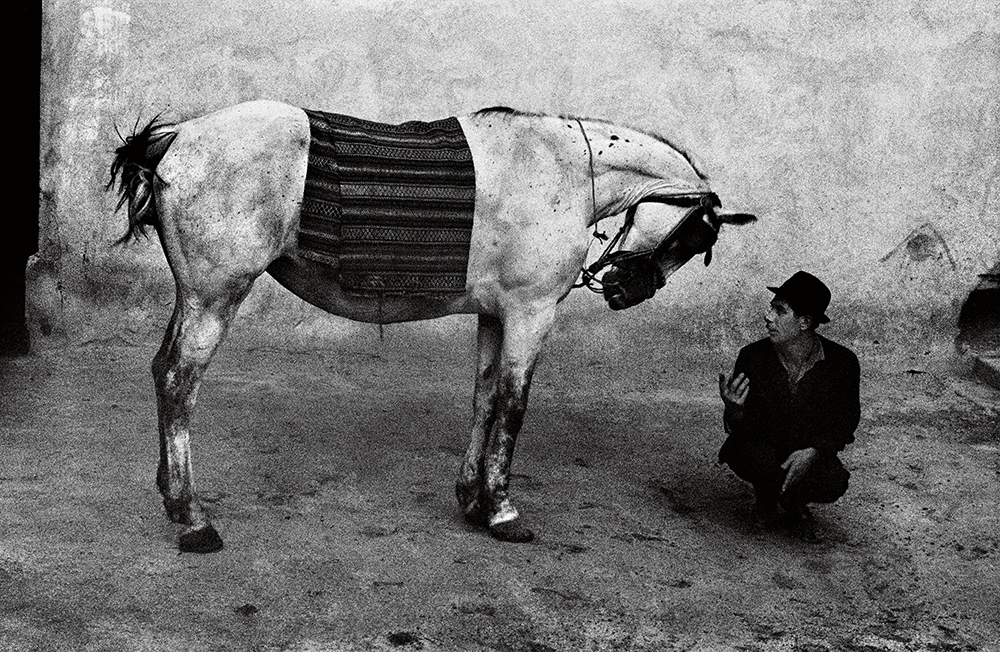
Josef Koudelka. Romania, 1968; from Josef Koudelka: Next (Aperture, 2023). © 2023 Josef Koudelka/Magnum Photos and courtesy of the Josef Koudelka Foundation.
JH: I want to come back to you with the last question. You’ve spent most of your career in the world of photography—from education to exhibitions—and specifically, after many years at Aperture (including as editor-in-chief of the magazine), you’ve devoted yourself to writing. Rarely, if ever, have I come across a book about a photographer that is so sensitive in its approach, so circumspect in its reach and, frankly, so beautifully written. So in closing, tell me: what was it about Josef Koudelka that captured your curiosity, and clearly—your heart?
MH: Again, I so appreciate your words here—thank you.
I think my answer may sound really goofy and simplistic, but here goes: I’m utterly excited and captivated by talent, intelligence, obsessiveness, passion, candor, and commitment. How’s that for a laundry list?! Koudelka’s unsentimental, all-in appetite for life, and his tireless determination with his work, and the extraordinary beauty and humanness in so many of his photographs, were and remain a tonic for me. I already had deep respect and admiration for his work and his work ethic—his integrity as an artist. I also liked him. We had worked well together previously, and I trusted him to do what he said he was going to do. If he agreed to give me his time and access—to both him and his materials—I knew he would. Very importantly (to me), I knew he would not ever try to censor, or tell me what I could and could not write. The most wonderful thing is, at the end of this almost ten-year process, my appreciation for (and understanding of) his work has only continued to increase—there continue to be revelations and surprises.
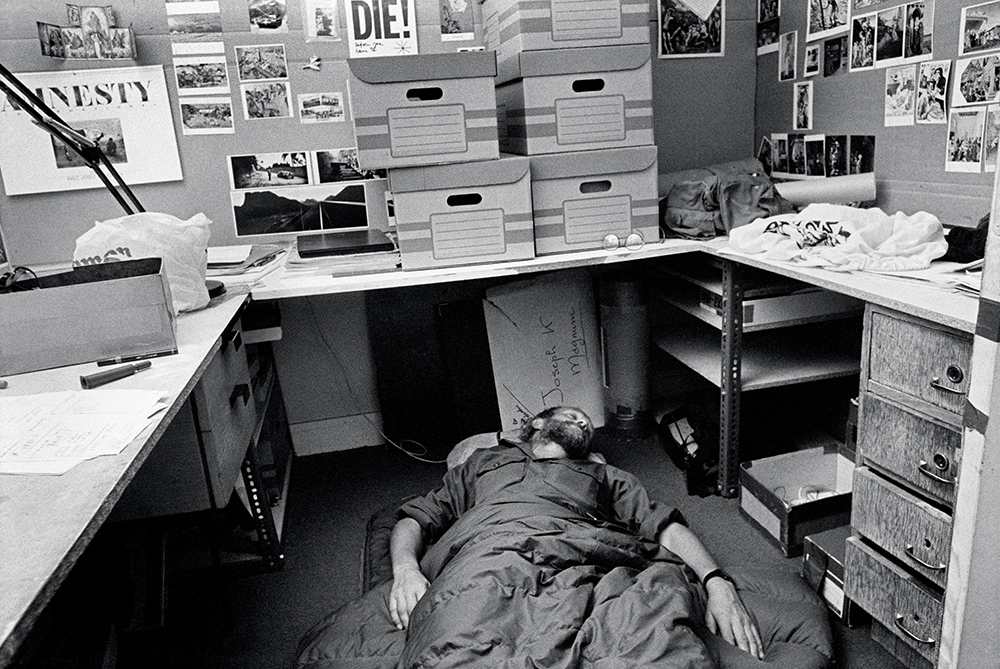
JK's work and sleep space, Magnum Photos, Paris, 1989. (Camera on self-timer); from Josef Koudelka: Next (Aperture, 2023). © 2023 Josef Koudelka/Magnum Photos and courtesy of the Josef Koudelka Foundation.

